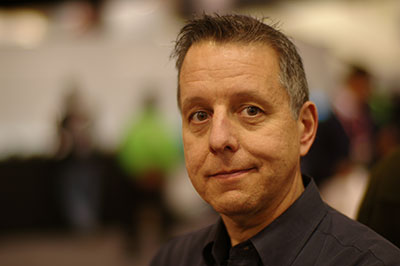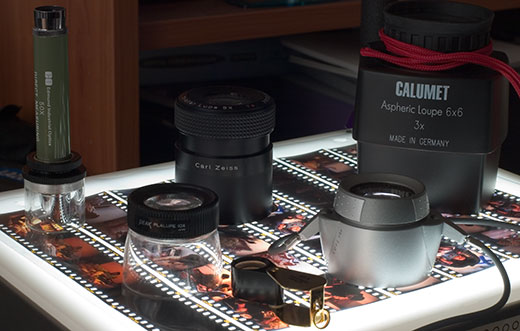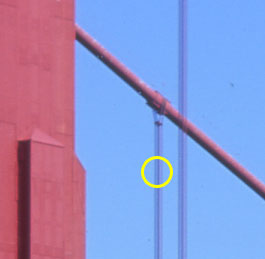MacWorld SF roundup
I work a mere four blocks away from the Moscone Center, where the annual MacWorld SF trade show is held, so naturally I just drift there during my lunch break, possibly extended… Here is a list of strange and wonderful things I saw during the show, and that might have been overlooked by the more mainstream sites:
iLugger
The iLugger is a carrying case for the iMac G5 (it fits both the 17″ and 20″ models). Most laptops are always connected to the mains and seldom used as real mobile devices, and an iMac G5 will give significantly better performance at 2/3 the price of a PowerBook. Interestingly, the company making it is a blimp manufacturer, clearly a case of someone scratching their own itch.
Epson RD-1
 Not a new product, but I got to handle an Epson R-D1, a limited edition Leica M compatible rangefinder digital camera (the only one of its kind) based on a Voigtländer-Cosina Bessa R2 body. I shot a few samples with a 50mm Summicron and Noctilux, and the resulting pictures are remarkable clear and sharp. Noise levels at ISO 800 are significantly better than my Canon EOS 10D, no small feat, and given a rangefinder’s 2-3 stop advantage over a SLR, this looks like an ideal available-light camera.
Not a new product, but I got to handle an Epson R-D1, a limited edition Leica M compatible rangefinder digital camera (the only one of its kind) based on a Voigtländer-Cosina Bessa R2 body. I shot a few samples with a 50mm Summicron and Noctilux, and the resulting pictures are remarkable clear and sharp. Noise levels at ISO 800 are significantly better than my Canon EOS 10D, no small feat, and given a rangefinder’s 2-3 stop advantage over a SLR, this looks like an ideal available-light camera.
The Bessa R2 has a relatively short rangefinder base length, which reduces its focusing accuracy compared to a Leica. The hardest lens to focus is the Noctilux-M 50mm f/1.0 (yes, you read that right, the fastest production lens in the world), due to its very shallow depth of field at low aperture, as shown in the picture to the left. I took it with a Noctilux (ISO 200, f/1.0, 1/125) at close to its minimum distance of 1 meter, and focusing accuracy seems adequate… Click on the image for the full-size JPEG with EXIF metadata (not including the manually set aperture and focus, of course). For comparison purposes, here is the corresponding JPEG I shot yesterday (ISO 800, Summicron-M 50mm f/2, 1/30, aperture unrecorded, probably f/4).
The gentleman portrayed is an Epson representative who was apparently given the charge of watching over this $3000 camera (apparently his only task). The sight of me pawing over it might explain his expression…
I won’t duplicate Luminous Landscape’s review, and didn’t have that much time to play with the RD-1 in any case. Build quality is good, as good as the 10D at least. It does not have the satisfying heft of my Leica MP, nor its superlative 0.85x viewfinder, but then again what does? Some retro touches like the dials are an affectation, as well as the manually cocked shutter. The shutter cocking lever does not have to advance film, and its short travel feels somewhat odd.
X-Rite Pulse ColorElite
X-Rite, a maker of color calibration hardware, was demonstrating its Pulse ColorElite bundle, resulting from its acquisition of the color management software vendor Monaco Systems. This package allows you to calibrate with precision the color characteristics of a monitor, scanner, digital camera and printer, for consistent, professional-grade color management. It goes much beyond simple and now relatively inexpensive monitor calibration colorimeters, by also using a spectrophotometer (an instrument that measures light across the visible spectrum, wavelength by wavelength), and the price is correspondingly higher. The market-leading product is the GretagMacbeth Eye-One Photo. X-Rite has clearly replicated the Eye-One package, but at a slightly lower price, and with some nice touches that significantly improve usability. The Eye-One spectrophotometer (which is used both for calibrating monitors and prints, a GretagMacbeth patented technology) is reportedly more accurate, however (3nm vs. 20nm). The Pulse bundle retails for $1300, the Eye-One for $1400.
FrogPad
The FrogPad is a small one-handed Bluetooth keyboard designed to be used with PDAs or smartphones, but it can also be used with a Mac or PC as it follows the standard Bluetooth Human Interface Device (HID) profile. You can hold it in one hand and type with the other. I don’t know how long it takes to get used to it, but at any rate they are offering $50 off the regular price of $179 if you use the code Apple50. They also has a mockup of a folding version in cloth, for use in wearable computing.
Interwrite Bluetooth tablet
CalComp used to make high-end tablets and digitizers for architects, engineers and artists. The tablet market is pretty much monopolized by Wacom, nowadays, but CalComp is still around (after being bought out by GTCO). They were demonstrating a Bluetooth tablet for use by teachers in a classroom setting (although I am not sure how many cash-strapped school districts can afford the $800 device).
JetPhoto
There was a cluster of small Chinese companies exhibiting. One of the more interesting was Atomix, a company that makes JetPhoto, a digital photo asset management database, similar to Canto Cumulus or Extensis Portfolio. Apparently, their forte is the integration of GPS metadata and the image database, you can do geographical selections on a map to find photos. It also had many export functions with a comprehensive database of cell phones and PDAs to export photos to. Unfortunately, the current version does not support sophisticated hierarchical, set-oriented categories, the one feature in IMatch I find absolutely vital.
The program looked impressively polished for a first version, and is available free to download for now. This is yet another illustration of how the Chinese are rapidly advancing up the value chain, and American firms could be in for a nasty surprise if they maintain the complacent belief high-end jobs are their birthright and only unqualified manufacturing jobs or menial IT tasks are vulnerable to Chinese (or Indian) competition.
Fujitsu ScanSnap
One of the few things I still use my Windows game console PC for is to drive my Canon DR-2080C document scanner. This small machine, the size of a compact fax machine, can scan to PDF 20 pages per minute (and it can scan both sides simultaneously). It is intended for corporate document management, but is also very useful to tame the paper tiger by batch-converting invoices, bills and so onto purely electronic form, in a way that is not practical using a flatbed scanner.
It seems Fujitsu is bringing that functionality to the Mac with the similarly specified ScanSnap fi-5110EOX. The scanner is driven with a bundled version of Adobe Acrobat 6.0. I can well see this becoming popular in small businesses run on Macs, although the Fujitsu reps on the stand implied they were here to gather potential customer feedback to make a stronger case for enhanced Mac support with their management and accelerate the release of Mac drivers for it.
Ovolab Phlink
My office PBX is actually a PC-based CTI unit made by Altigen, and voice mails left to me are automatically forwarded to me as WAV attachments in an email. That has major usability benefits – I can set email rules to drop voice mails when the attachment is too small (usually someone who hanged up on the voice mail prompt), or fast forward and rewind during message replay. This feature is addictive – voice mail still sucks compared to email (disk hogging, not searchable or quickly scannable), but being liberated from excruciatingly slow voice-driven user interfaces, replete with unnecessarily deliberate and verbose prompting, makes it somewhat bearable.
I did not have this kind of functionality at home, however. It is possible VoIP devices will offer it at some point, but that does not seem to be the case in low-end home VoIP for now. I tried experimenting with the open-source Asterisk PBX, but did not have the time to pursue this, and in any case I’d rather not have to install a dedicated Linux machine at home just for this purpose (my home network runs on Solaris/x86, thank you very much).
Fortunately, Ovolab, an Italian company based near Milan, has introduced Phlink, just what I was searching for, and I actually bought one on the spot. It is a small USB telephony attachment that plugs into a phone line and turns your Mac into a sophisticated CTI voice-mail system. It is fully scriptable using AppleScript and supports Caller ID. I have yet to use it extensively (the hardest part, interestingly, is bringing a phone cord close enough to my Mac).

 For a real-world test, I took my
For a real-world test, I took my  I picked up the hardcover edition of this book from the sale bin at
I picked up the hardcover edition of this book from the sale bin at